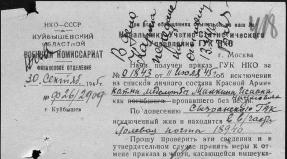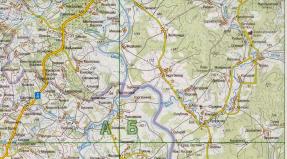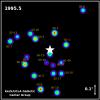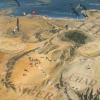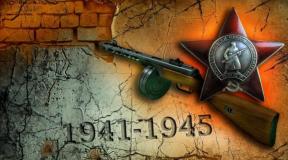Archive of the armed forces of the ussr search by last name. Search for relatives who fought on the fronts of the Great Patriotic War. Additional sources for finding missing persons
Instructions for finding information about soldiers who did not return from the front.
Every May 9, the "Immortal Regiment" is held. I would also like to participate, but I know almost nothing about my veteran relatives. Where can I find information?
In the Great Patriotic War, more than 6.3 million soldiers died, 4.5 million were missing. The fate of the dead and missing is not known to every family. The reasons for this can be completely different. But, fortunately, today this information can be found out, even if no documents and photographs of the soldier have survived. Most of the archival files of the period of the Great Patriotic War have already been digitized and are stored in public databases on the Internet. With their help, you can trace the combat path of a soldier, learn about his wounds, awards, place and circumstances of death, place of burial.
My husband's mother's father was drafted to the front in July 1941 and died in one of the first battles, - shared the journalist of the portal Svoykirovsky Valentina Rogacheva. - Mother's funeral came - "Killed." But there was no burial place, nor any information at all. Then the village where my mother-in-law's family lived was burned by the Germans during the retreat, and there was no information at all about her father: no photographs, no documents - everything burned down. All her life she dreamed of learning at least something about her father. And so, by the 70th anniversary of the Victory, I found out in the news that the data of the soldiers of the Great Patriotic War were being digitized. We started looking for information on the Internet. All we knew was name, year of birth and year of conscription. In one of the publicly available databases, they found him in the lists of those buried in a mass grave on the territory of Belarus and a note that he died in battle. And although the place of burial is indicated not quite definitely, now it is at least clear that he died not in captivity, but in battle, that he was buried, albeit in a mass grave.
So, all you need to know for the first stage of the search is the surname, name and patronymic of the deceased or missing person, his date and place of birth. You can find out from your relatives. It is also advisable to know where the soldier was called.
What databases can be used
There are four main databases with documents digitized from archives, which are constantly updated:
- ... Generalized databank of the dead and missing during the Great Patriotic War and the post-war period. The personal information contained in them is more than 20 million records;
- ... The databank contains 12.5 million records of awards with orders and medals "For Courage" (about 4.6 million people were awarded) and "For Military Merit" (more than 5.2 million people were awarded), as well as 22 million cards of the registration card index and card indexes of awarding the Orders of the Patriotic War of I and II degrees to the 40th anniversary of the Victory;
- ... The portal was created by the Ministry of Defense by the decision of the Russian organizing committee "Victory". It summarizes the data banks "Memorial" and "The feat of the people in the Great Patriotic War of 1941-1945." Here you can see historical maps and war logs;
- - site of the all-Russian movement "Immortal Regiment". Users independently upload data about their frontline relatives. At the moment, there are more than 400 thousand records in the "Immortal Regiment" database.
Screenshot from the website obd-memorial.ru
However, there are a few things to keep in mind. Firstly, the name of a soldier when entering the front could be written incorrectly (for example, Snigirev instead of Snegirev, Kiril instead of Kirill), the same applies to the date of birth (some recruits themselves asked to change their age in order to go to the front). So if you can't find a person by the exact name and date of birth, you can try to write the surname as it would be perceived by ear, and change the year of birth by a couple of years up or down. Secondly, if you are looking for information on the place of conscription or birth, you need to remember that the administrative-territorial division of the regions of the RSFSR has changed. For example, Oparinsky, Lalsky and Podosinovsky districts were included in the Kirov region only in 1941, and before that they belonged to the Arkhangelsk region. You can check the administrative division on the website, and you can learn more about the intricacies of database search.
In addition to databases on the Internet, there are also Memory Books. These are large printed editions in several volumes, in which the victims of the Great Patriotic War are listed by name (alphabetically). There are such Books in every region: in Kirov, you can ask for them in the Herzen Library. It may be that the name of your relative is not in any of the databases or in the Book of Memory. In this case, you can try to send the official by mail (!) To the Central Archives of the Ministry of Defense of the Russian Federation. But for this you need to know more accurate information about the deceased (for example, in what unit he served) and you will have to wait about six months for an answer.By the way, in rare cases, you can also find letters from the front. For example, on websites and or in a digitized "Letters from the Front" (must be viewed manually). But you will have to search by last name and initials.
What if a soldier is missing?
Counting of the missing during the Great Patriotic War is still under way. Various researchers cite the figure from 4 to 7 million people. It is difficult to determine the exact number, since in the front-line reports, the missing were sometimes combined with the prisoners or included in the lists with the total number of casualties. About 500 thousand people were mobilized in the early days of the war, but were not included in the lists of troops. Some families received neither letters from the front nor "funerals".
Information about the missing person can also be stored in one of the open databases. First of all, this is the same HBS "Memorial". If you have information that a soldier was captured, try typing his first and last name in Latin (Ivan Petrov). In addition, there is a separate electronic data on prisoners of war - the Saxon Memorials.Those who were taken into German captivity are listed in alphabetical order. If the German camp in which the prisoner of war was located was liberated by Soviet troops, after the end of the war, such a person could get into the NKVD testing and filtration camp. Alas, there is an electronic database of PFL prisoners only for the natives of the Perm Territory. You can try to find filtration and verification files and captured German cards through the State Archives of the Kirov Region
Search teams can also help in finding information about the missing. Since 1989, in the regions where there were hostilities, "Memory watches" have been held, during which search engines raise the fallen soldiers, identify their identities and then search for relatives throughout the country. Some keep documents that help to identify a person, in rare cases - letters to relatives or personal items with a signature (for example, a spoon). But, as a rule, a person can be identified by a soldier's medallion - a small metal capsule in which a piece of paper with a soldier's data was put.

Photo: serovglobus.ru
It indicated the name, military rank, year and place of birth, the place of mobilization and the address of the family. An archive of records from all found medallions can be found on the Internet: they are entered into special books - "Names from Soldiers' Medallions", which are published on the Search Movement of Russia. By looking for a familiar name in the lists, you can find out when, where, and by whom a fighter was found. If the record contains information that the relatives of the deceased have been found, you can request their contacts in the search party. You can also search for information on the surname of the fighter.
And now, briefly:
1. Find out from the relatives of the deceased his full name, place and date of birth, as well as the year and place of conscription.
2. We are looking for information in databases. First of all, through the Memorial HBS. Trying to type in your full name with mistakes: the way they are perceived by ear.
3. We are looking for additional information: we find out the combat path of a soldier and awards on the site "Memory of the People".
4. We are looking for digitized or decrypted frontline letters on the Internet by the name of the soldier.
www.rkka.ru - a directory of military reductions (as well as charters, manuals, directives, orders and personal documents of wartime).
Libraries
oldgazette.ru - old newspapers (including the war period).
www.rkka.ru - description of military operations of the Second World War, post-war analysis of the events of World War II, military memoirs.
Military maps
www.rkka.ru - military topographic maps with a combat situation (by periods of war and operations)
Search engine sites
www.rf-poisk.ru - the official website of the Search Engine of Russia
Archives
www.archives.ru - Federal Archival Agency (Rosarkhiv)
www.rusarchives.ru - industry portal "Archives of Russia"
archive.mil.ru - Central archive of the Ministry of Defense.
rgvarchive.ru - Russian State Military Archive (RGVA). The archive stores documents on the military operations of the Red Army units in 1937-1939. near Lake Khasan, on the Khalkhin-Gol river, in the Soviet-Finnish war of 1939-1940. Here - documents of the border and internal troops of the Cheka-OGPU-NKVD-Ministry of Internal Affairs of the USSR since 1918; documents of the Main Directorate for Prisoners of War and Internees of the USSR Ministry of Internal Affairs and institutions of its system (GUPVI USSR Ministry of Internal Affairs) of the period 1939-1960; personal documents of Soviet military leaders; documents of foreign origin (trophy). On the website of the archive you can also find guides and reference books that make it easier to work with it.
rgaspi.org - Russian State Archive of Social and Political Information (RGASPI). The period of the Great Patriotic War in the RGASPI is represented by documents of an emergency body of state power - the State Defense Committee (GKO, 1941-1945) and the Headquarters of the Supreme Commander-in-Chief.
rgavmf.ru - Russian State Archives of the Navy (RGAVMF). The archive stores documents of the Russian Navy (late 17th century - 1940). Naval documentation of the period of the Great Patriotic War and the post-war period is stored in the Central Naval Archive (TsVMA) in Gatchina, which is under the jurisdiction of the Ministry of Defense of the Russian Federation.
victory.rusarchives.ru - a list of federal and regional archives of Russia (with direct links and descriptions of collections of photographic and film documents from the period of the Great Patriotic War).
Partners of the "Stars of Victory" project
www.mil.ru - Ministry of Defense of the Russian Federation
www.histrf.ru - Russian Military Historical Society
www.rgo.ru - Russian Geographical Society
The further the era of severe war, mass deaths, heroism and deeds of Soviet people goes, the more it becomes necessary to remember the events of those years. More than seventy years have passed in 2017. Whole generations of Russians were born and even died who had never seen war. But despite the long period, there are still many blank spots in the history of the country. For example, where to find the participants of the Second World War?
Identification problems
There are still questions about how to find a participant in the Second World War by the name of such and such. How many of them, nameless, remained on the battlefields? A huge variety. Of course, relatives, volunteers, and official authorities were looking for them and are looking for them. But there are still a lot of those who have not been found, and this process will not be completed soon. Although the movement, of course, is on. In the twenty-first century, information about the participants in the Second World War helps to find new means of information retrieval. In particular, material about the warriors of the past war can now be found thanks to the emergence and rapid development of new technologies.
Search on the Internet
How to find a WWII participant by last name on the world wide web? The first stage in the search for a front-line soldier of a bygone war should be the collection of any, even the smallest, data - facts, statistics, old photographs from the war that remained in dusty family archives. Some material may remain with relatives who have various written sources - letters from the war, military newspapers, various documents. When the vast majority of the evidence has been accumulated, you can work with the Internet by looking at the content of specialized sites (by the way, most of the content of such resources is regularly updated). Usually they contain information about the front-line soldiers of the past battle.

The site "The feat of the people"
How to find a participant of the Great Patriotic War by last name using the "People's Feat" website? The Ministry of Defense of the Russian Federation has formed a unique website that collects most of the facts and statistics about front-line soldiers of past battles. Here you can find a variety of archival materials, selected on the topic of the battles of the past war. The resource menu is equipped with a good interface, with the support of which you can easily find the necessary material on topics of concern to society. This information is always up to date.
Winners website
How to find a participant of the Second World War by last name through the site "Winners"? A good, informative bank, unique in terms of the proposed content, of documents of various topics, affecting the events of the war period. The content of the site includes a large amount of material about the front-line soldiers of the Russian Federation and other countries of the near and far abroad. All materials are accumulated thanks to the voluntary actions of the population, businessmen, government agencies of Russia.

Television programs
How to find a WWII participant by last name through television programs? If you ask for support from the workers of a specialized international project that does not know how to compare with other programs - "Wait for me", you will be able to find the largest amount of material about the wanted front-line soldier of the past war. At the same time, material about the killed and perished war veterans is often sought from all sides hostile during the war years. You can analyze the content of the site (or send a message with a request). It is possible to fill out a questionnaire. And in this case, we can only hope for positive results.
Specialized sites
It is possible to find information about a participant in the Second World War, to find unique materials on such websites as “Memorial”, “Memory of the People” and others, which are serious in terms of the volume of material. Here, on the pages of sections, rare information is published, unique data about the war in general and about individual historical figures. The lack of content is the strong ideological side, which often reduces the value of the material.

Other sources
You can find the deceased participant of the Second World War using other sources. For example, it is possible to analyze the "Book of Memory" ("Soldiers of Victory"). In the multivolume, in alphabetical order, soldiers and commanders who died in the war are recorded with a short biography in the war. The disadvantage is information gaps. There are various electronic libraries (RKKA, "Old Newspapers") and archives of war battles (CA MO, RGASPI, RGAVMF, etc.). The funds of these organizations contain information about battles, little-known data about the life of the country during the years of a difficult war, about people killed at that time.
In addition to special sites, other bodies will help to find a grandfather, a participant in the Second World War. Those wishing to find the deceased grandfather will be supported by various school and extracurricular institutions, scientific and general cultural organizations. You can ask them to share information about your relative who died during a difficult and painful war.
Shared Sites
Nowadays, every Russian can do a noble, albeit difficult, job - the search for information about the front-line soldiers of the war era, materials about the killed and missing. To research the originals, where individual information about the veterans is located, there are many common sites that are quite popular.
Where can you find the participants of the Second World War? There are many sources here. For example, podvignaroda ("The feat of the people") is a free for general access site of materials about the awardees and awards of the era of past battles, from the moment of which more than seventy years have passed. Obd-memorial is a site for analyzing the available material about front-line soldiers, warriors, killed and lost in the crucible of battles and post-war Stalinism. You can also find a grandfather, a participant in the Second World War, on the website pamyat-naroda ("Memory of the People") - this is a free for access bank of materials about the fate of front-line soldiers of the war era. Search for military cemeteries of that period, materials about awards, about the military fate of front-line soldiers, about moments of military history.

- Dokst - materials about those killed in the countries of the fascist bloc.
- Polk - data on Russian warriors from different eras who went missing in the battles of the twentieth century.
- Pomnite-nas ("Remember us") - pictures of military graves.
Published editions
Otechestvort.rf, rf-poisk - electronic version of the publication "Names from Soldiers' Medallions" (Volumes I - VI). Here, in alphabetical order, are materials about those killed during the war, the ashes of which, found during the excavation process, were identified.
How to search?
After you have familiarized yourself with the sources, you need to give a short instruction on how to find the front-line soldier you need.

Finding information about the participants in the Second World War is not too difficult. Try to find a front-line soldier by last name with the support of one of the specialized sites. Initially, you can simply research the materials published on the portal and excerpts from separate archives with information about those killed and lost in the war and about the later life of those who managed to stay alive without dying either in the Nazi camps or in the Stalinist Gulag.
Conduct a more thorough search using a special electronic questionnaire. Place the personal data of the front-line soldier in the appropriate columns. In the event that additional material is available to you, in particular, the time of service and rank, the awards with which the soldier was awarded, be sure to mark them. If the initial search fails completely, and the results of the work remain negative, do not lose heart. The databases on these sites are updated from time to time. In addition, try to view the material about the front-line soldier on the sites with the support of various Internet search engines. It is enough to put the veteran's data in the search engine line, as well as any additional information to see various material about him.
How else to find the lists of participants in the Second World War? An attempt can be made to search for a front-line soldier by personal data by analyzing the generalized database "Memorial" of the RF Ministry of Defense, located on the official website. There is also a questionnaire for filling out information about the veteran. Based on the results of the research, you will receive information about the life of a front-line soldier, obtained from the surviving lists of "Reports of Irrecoverable Loss". All kinds of data found can be useful in further searches.
It is recommended to inquire at the recruiting office at the place of conscription of the front-line soldier at the beginning of the service in order to find him by personal data. Submit an application asking for information about the wanted front-line soldier, noting your level of kinship and all information found about him. Then wait for a response.
If you could not find a person who participated in the Second World War, contact the CA MO, located in the city of Podolsk near Moscow. It is enough to send a message to the address of this body with a request to transfer material about the missing front-line soldier during the battles. After a certain time, you will be sent an answer with materials about the burial place of the wanted front-line soldier or his further place of residence, if the veteran returned from the war alive.

The search for front-line soldiers is a noble business, many are engaged in search and excavation work of their own free will in order to help others find their dead relatives. The feat accomplished by the Soviet people during the Great Patriotic War should not be forgotten, because "as soon as the people stop remembering the last war, the next one comes."
Archives of participants in the Great Patriotic War
The creation of special information portals, providing information from the archives of the military events of 1941-1945, became possible after the declassification of documents of that time. At the same time, there are both state archives and those created by citizens.
The analysis made it possible to identify the following large databases of participants in the Second World War on the Internet:
- the "Memory of the People" portal;
- website of the "Immortal Regiment" movement.
There are other large archives that contain information about the soldiers of the wars of the 20th century. ("The Forgotten Regiment"), and about the burial places of the participants of the Great Patriotic War ("Remember us").
In the case of searching for information about burial places or obtaining additional information, it is advisable to use the archives in certain areas. You can find out how to find the burial place of a soldier who died during the war from the corresponding article on our website.
Where and how to find by the name of the Great Patriotic War participant and veteran
All of the above services allow users to independently search by the names of participants in the Second World War. To do this, it is enough to indicate the surname and other known information, including the name, patronymic and date of birth, in the search bar on the main page of the archive.
Some resources provide an advanced search that allows you to search by date of death, place of service, awards and other information that allows you to identify a person.
Don't know your rights?
In addition, the mentioned databases have their own characteristics:
- If there is information that a WWII participant died in the course of hostilities or died from an illness, it is recommended to search through the Memorial database.
- If you need to find information about the awarding in relation to a specific participant in hostilities in the period 1941-1945, it is better to use the capabilities of the "People's feat" resource. The system allows you to find award documents that were previously classified.
- If there is no information about the award, it is recommended to use the search in the "Memory of the People" document base. This unique service allows you to find information about a WWII participant and establish his fate, having received information about participation in specific hostilities and awards in chronological order from the moment of the call.
How to find a soldier by last name on the website of the Immortal Regiment
Unlike the resources discussed above, the Immortal Regiment project is based on information posted by the descendants of WWII participants who tell stories about their relatives. The system allows not only to search among existing information, but also to supplement the database with new information.
To search by last name in the upper right corner, you need to click on the magnifying glass and in the line that appears, indicate the name of the participant in the Great Patriotic War. As a result, all options will be displayed that fully or partially satisfy the search criteria.
In conclusion, we note that it is not always enough to search for WWII veterans by last name - it is usually problematic to find information only by this criterion in relation to a particular person due to the large number of namesakes. To get the result, it is recommended to use the advanced search, indicating additional information - for example, name, date of birth or military rank.
It will also be interesting for you to familiarize yourself with the materials that we have written specifically for our
Good day everyone!
Not so long ago I tried to help one friend find relatives who fought in the Second World War (1941-1945). Oddly enough, we quickly managed to find his grandfather, the number of his unit where he fought, also looked at several of his awards. The acquaintance was pleased and proud of his grandfather, but I was thinking ...
I think that almost every family has relatives who participated in the Great Patriotic War, and many would like to know more about them (which is why I decided to sketch this article). Moreover, many old people do not like to talk about the front, and it is not uncommon in a family that they do not even know all the awards of their grandfather!
By the way, many people mistakenly believe (and I, until recently) that in order to find at least something, you need to know a lot of information about a person, know how to access the archives (and where to go), have a lot of free time, etc. ... But in fact, now, to try to start a search, it is enough to know the name and surname.
And so, below I will consider several interesting sites in more detail ...
Addition!
If you have old photographs and you notice how every year they get worse and worse - digitize and restore them. Now any novice user can handle this -
# 1: The feat of the people

Very, very interesting site created by the Ministry of Defense of the Russian Federation. It is a large database in which all available documents from the military archives are entered: where and who fought, what awards he received, what feats, etc. Absolutely everything is entered, regardless of the rank and scale of the feat. I can add that the site database is unique in terms of its size.

Then you will be presented with a list of found people: note that there can be a lot of them if your relative has a common first and last name. Opposite each person will be displayed his year of birth, rank, order, medal (if any).

In the card itself, a lot of information is displayed per person: rank, place of call, place of service, date of the feat (if any), archival documents about the award, registration card, photo of a leaflet with a description of the feat, medal and order (example below).

In general, quite informative and complete. I recommend starting your search for a person from this site. If you are lucky, and you will find data about him here, then you will receive pretty decent information to continue your search (you will know the year of birth, part of where he served, where he was called from, etc. details that many do not already know about).
By the way, despite the fact that all the basic information has already been posted on the site, from time to time it is updated with new archived data. Therefore, if you did not find anything, try to log in after a while and search again, also use the sites that I will give below.
# 2: OBD Memorial

The full name of the site is the Generalized Data Bank.
The main purpose of this site is to enable citizens to find and learn about the fate of their relatives, find out the place of their burial, where they served, and other information.
The Military Memorial Center of the Armed Forces of the Russian Federation carried out a unique work, as a result of which you can use the reference system of global importance!
The data used to fill the database of this site are taken from official archival documents located in the Central Archive of the RF Ministry of Defense, the Central Naval Archive of the RF Ministry of Defense, the Russian State Military Archive, the State Archive of the RF, etc.
During the work, more than 16.8 million documents, over 45 thousand passports of military graves were scanned and posted on the network.
How to search for a person in the OBD
Yes, in general, it is standard. On the main page of the site, enter in the search fields all the information that you know. It would be very nice to enter at least a first name, last name, and patronymic. Then click the search button (example below).

In the data found, you will see the person's date and place of birth, by which you can navigate and start looking through the required profiles.

In the questionnaire, you can find out the following information: full name, date and place of birth, date and place of conscription, military rank, reason for retirement, date of retirement, name of the source of information, fund number, source of information. And also look at the scanned sheet itself with archived data.

No. 3: Memory of the people

Another huge database site created by the Department of Defense. The main goal of the project is to enable all users to get information about the participants of the Great Patriotic War through new web tools and the development of generalized data banks "Memorial" and "The feat of the people in the Great Patriotic War of 1941-1945."
To start searching for a person, just enter his full name (if any, then another year of birth). Then click the "Find" button.

Next, you will be shown all found people with similar initials. Having opened a card for a person, you will find out: the date of his birth, place of recruitment, military units, awards, dates of exploits, numbers of funds - sources of information, archive, you can see scans for which awards were given.

In addition, on this site you can see what the path that your grandfather took and fought on was. (example on the map below: the beginning of the path near Novosibirsk, then Tyumen, Yekaterinburg, Nizhny, etc.).
Note: the map is large enough, and the screenshot below shows a small piece of it.

Where grandfather was and fought - the path on the map!
# 4: Immortal Regiment

This is the official website of the Immortal Regiment movement. Those who live in Russia probably know and have heard about him. In general, I mentioned this site for the simple reason that you can try to search on it. (to do this, just type in the required full name into the search term of the site).

Search in the base of the movement (from the site "Immortal regiment")
By the way, I also want to note that the site has already collected about half a million profiles and they are constantly being added. In addition, you can tell your story about your grandfather (everything you know) and his profile will be entered into the site's database. (what if someone adds your information ?!).


Screenshot from the site "Immortal Regiment"
From the soldier's questionnaire, you can find out quite detailed information about him: name, rank, region, locality, history, etc. An example of a card is shown in the screenshot below.

How the soldier's profile will look like (screen from the site "Immortal regiment")
If you are looking for the burial place of your relatives who participated in the Second World War, I recommend that you familiarize yourself with this article:.
In it, you will learn how to correctly create a request to the archive, how to issue it, where to send it specifically. In general, very useful information.
Well, that's all for me, I hope helped, if not find, then at least gave useful "food" to start the search ...
